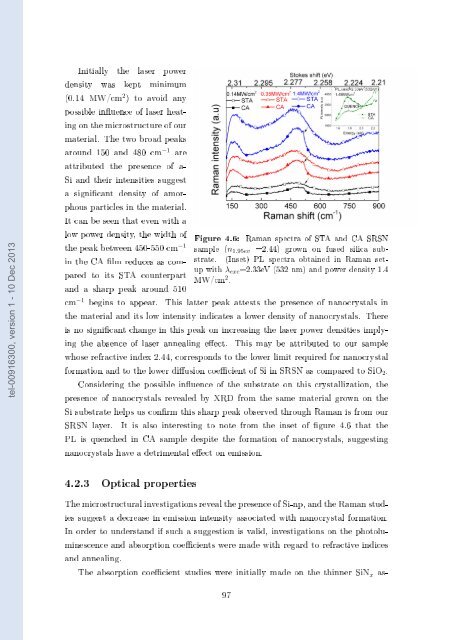Films minces à base de Si nanostructuré pour des cellules ...
Films minces à base de Si nanostructuré pour des cellules ...
Films minces à base de Si nanostructuré pour des cellules ...
Create successful ePaper yourself
Turn your PDF publications into a flip-book with our unique Google optimized e-Paper software.
tel-00916300, version 1 - 10 Dec 2013<br />
Initially the laser power<br />
<strong>de</strong>nsity was kept minimum<br />
(0.14 MW/cm 2 ) to avoid any<br />
possible inuence of laser heating<br />
on the microstructure of our<br />
material. The two broad peaks<br />
around 150 and 480 cm −1 are<br />
attributed the presence of a-<br />
<strong>Si</strong> and their intensities suggest<br />
a signicant <strong>de</strong>nsity of amorphous<br />
particles in the material.<br />
It can be seen that even with a<br />
low power <strong>de</strong>nsity, the width of<br />
the peak between 450-550 cm −1<br />
in the CA lm reduces as compared<br />
to its STA counterpart<br />
and a sharp peak around 510<br />
Figure 4.6: Raman spectra of STA and CA SRSN<br />
sample (n 1.95ev =2.44) grown on fused silica substrate.<br />
(Inset) PL spectra obtained in Raman setup<br />
with λ exc =2.33eV (532 nm) and power <strong>de</strong>nsity 1.4<br />
MW/cm 2 .<br />
cm −1 begins to appear. This latter peak attests the presence of nanocrystals in<br />
the material and its low intensity indicates a lower <strong>de</strong>nsity of nanocrystals. There<br />
is no signicant change in this peak on increasing the laser power <strong>de</strong>nsities implying<br />
the absence of laser annealing eect. This may be attributed to our sample<br />
whose refractive in<strong>de</strong>x 2.44, corresponds to the lower limit required for nanocrystal<br />
formation and to the lower diusion coecient of <strong>Si</strong> in SRSN as compared to <strong>Si</strong>O 2 .<br />
Consi<strong>de</strong>ring the possible inuence of the substrate on this crystallization, the<br />
presence of nanocrystals revealed by XRD from the same material grown on the<br />
<strong>Si</strong> substrate helps us conrm this sharp peak observed through Raman is from our<br />
SRSN layer. It is also interesting to note from the inset of gure 4.6 that the<br />
PL is quenched in CA sample <strong>de</strong>spite the formation of nanocrystals, suggesting<br />
nanocrystals have a <strong>de</strong>trimental eect on emission.<br />
4.2.3 Optical properties<br />
The microstructural investigations reveal the presence of <strong>Si</strong>-np, and the Raman studies<br />
suggest a <strong>de</strong>crease in emission intensity associated with nanocrystal formation.<br />
In or<strong>de</strong>r to un<strong>de</strong>rstand if such a suggestion is valid, investigations on the photoluminescence<br />
and absorption coecients were ma<strong>de</strong> with regard to refractive indices<br />
and annealing.<br />
The absorption coecient studies were initially ma<strong>de</strong> on the thinner <strong>Si</strong>N x as-<br />
97
















